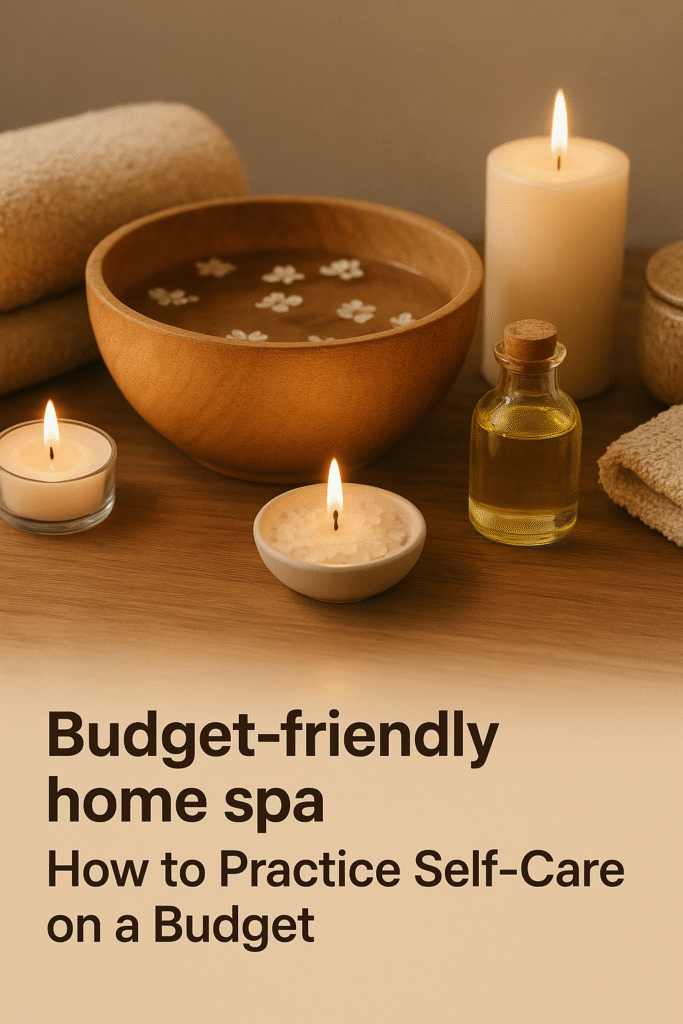How to Practice Self-Care on a Budget — 12 low-cost, science-backed ways to boost your mental and physical health without breaking the bank. Start today.
Slug
how-to-practice-self-care-on-a-budget-12-affordable-ways

How to Practice Self-Care on a Budget: 12 Affordable Ways to Prioritize Your Well-Being
Introduction — What, How, and Why
What is budget-friendly self-care? How can you support your well-being without draining your bank account? And why does it matter more than ever?
If you’ve ever scrolled through Instagram wellness posts, you might think self-care requires luxury spa trips, $50 face masks, or expensive yoga retreats. The truth? How to Practice Self-Care on a Budget is simpler than you think — and far more powerful than an occasional splurge. Real self-care is about consistent habits that keep your body, mind, and emotions healthy. You don’t need a high income to sleep better, reduce stress, and feel more energized. You just need intention, creativity, and a little planning.
This guide will walk you through 12 affordable, research-backed ways to make self-care a non-negotiable part of your life — without overspending.
Why Low-Cost Self-Care Works (Science-Backed)
How to Practice Self-Care on a Budget isn’t just about saving money — it’s about sustainability. Studies show that small, daily self-care actions help:
- Lower stress hormone levels (cortisol)
- Improve sleep quality and focus
- Reduce risk of depression and anxiety
- Increase productivity and emotional resilience
For example, forest bathing — spending time in green spaces — has been linked to lower blood pressure and improved mood. Short meditation sessions reduce anxiety symptoms in as little as eight weeks. Even simple breathing exercises have measurable effects on heart rate and stress levels.
The Reality Check — Self-Care Doesn’t Have to Be Expensive
There’s a common myth that you need to spend big to care for yourself. Social media often shows self-care as a glossy, high-price lifestyle. But everyday self-care can be:
- A 10-minute walk in nature
- Journaling your thoughts
- Cooking a simple meal from scratch
- Practicing gratitude before bed
The goal of How to Practice Self-Care on a Budget is to replace the idea of self-care as an occasional indulgence with something you weave into daily life — at little to no cost.

12 Affordable Ways to Practice Self-Care on a Budget
1. Build a Micro Morning Routine (5–15 Minutes)
Why it works: Morning rituals help set your day’s tone.
How to do it: Wake up 10 minutes earlier three times a week. Do 2 minutes of deep breathing, 3 minutes of stretching, and 5 minutes of journaling.
Extra tip: Place your phone away from your bed so your first moments are distraction-free.
2. Practice Free Guided Meditation
Meditation can reduce stress and improve mood in weeks. Use free YouTube videos or apps like Insight Timer.
Starter tip: Search “5-minute guided meditation” and try it before bed.
3. Spend Time in Nature
Just 20 minutes outside can significantly lower stress.
Affordable ideas:
- Visit a nearby park
- Start a balcony herb garden
- Walk tree-lined streets mindfully
4. DIY Spa Days at Home
Self-care doesn’t require a salon visit. Use kitchen staples: sugar scrubs, oatmeal masks, or herbal teas for facial steaming.
Pro tip: Dim the lights, play calming music, and make it a full sensory experience.

5. Read or Listen to Free Audiobooks
Join your local library’s digital program (Libby/OverDrive) to access free eBooks and audiobooks. Reading helps reduce stress and improve focus.
6. Declutter in 10-Minute Bursts
Messy spaces can contribute to mental clutter.
How to do it: Pick one surface a day — your desk, bedside table, or kitchen counter — and clear it. Minimalism can be therapeutic.
7. Cook Nutritious, Low-Cost Meals
Balanced meals don’t have to be pricey. Use seasonal produce, beans, and whole grains. Batch cooking reduces cost and time.
Example: A hearty lentil soup for under ₹50 per serving.

8. Keep a Gratitude Journal
Daily gratitude has been linked to higher happiness levels. Write down three good things each night. They can be small — a good cup of tea, a smile from a stranger, or finishing a task.
9. Exercise for Free at Home
Bodyweight workouts, yoga flows, or dance sessions need no equipment. YouTube has thousands of free fitness videos for all levels.
10. Reduce Screen Time
Too much screen time can lead to poor sleep and anxiety.
Tip: Set a “digital sunset” an hour before bed — read, stretch, or listen to music instead.
11. Connect with Loved Ones
Social wellness matters as much as physical health. Plan weekly calls or in-person walks with friends or family. It’s free emotional nourishment.
12. Volunteer Your Time
Helping others improves mood, reduces stress, and builds purpose. Find local opportunities that match your interests — from tutoring kids to community gardening.
30-Day Budget Self-Care Challenge
Week 1 — Morning routine + gratitude journal
Week 2 — Nature walks + free meditation
Week 3 — DIY spa + healthy cooking
Week 4 — Digital detox + volunteering
By the end, you’ll have a low-cost, high-impact wellness habit system.
Tools & Resources for Affordable Self-Care
- WHO Self-Care Month resources (outbound link)
- Global Wellness Institute reports on the wellness economy (outbound link)
- Free meditation & fitness apps
- Local library programs for books/audiobooks
Conclusion — Why to Start Today
You don’t need a luxury budget to care for yourself. In fact, How to Practice Self-Care on a Budget proves that the most effective self-care routines are often the simplest and most affordable. Whether it’s a 5-minute morning meditation, a nature walk, or a home-cooked meal, what matters is consistency. Choose two habits from this list today — and in 30 days, you’ll see the difference in your energy, mood, and outlook.





